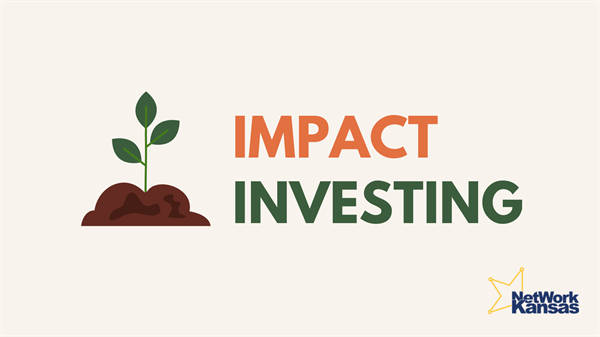
The Path of the Kansas Community Investment Fund So Far
By: Thomas Papadatos
NetWork Kansas
[email protected]
(316) 425-6033
www.networkkansas.com
Introduction
The Kansas Community Investment Fund (KCIF) was launched in 2019 as a three-year, gap-financing initiative to tackle health equity issues Kansans are facing. Resulting from a partnership between NetWork Kansas and the Kansas Health Foundation (KHF), $3 million was allocated to the fund over the three-year period. This was the beginning of a joint effort to develop an impact investing model to unlock capital and mobilize more assets across the state. Impact Investing is an investment strategy that aims to generate specific beneficial social or environmental effects in addition to financial gains. The point of impact investing is to use money and investment capital for positive social results. (Investopedia) As we enter into the third year with a diverse portfolio of projects, the path we took is not what we would have imagined. The ideas we tried and changed were essential to progress and created a framework driven by a vision. From convoluted program requirements to changes in scope, we look at the boxes of outdated marketing collateral to see where it all began.
Where It Started
Since inception, the mission of the Kansas Community Investment Fund has been grounded in the Kansas Health Foundations Impact Areas: Access to Care, Education Attainment, Healthy Behaviors, and Civic Engagement. On top of the health-focused mission, organizations must be rural, urban-distressed, minority, or woman owned businesses. These requirements were consistent with existing NetWork Kansas programs and the overall goal of deploying capital to underserved demographics and geographies.
We began the program by evaluating existing for-profit NetWork Kansas and E-Community deals for program fit, buying out these deals, and moving them into the KCIF portfolio. These loans were already vetted through our statewide loan program process and gave the KCIF portfolio a solid foundation. We referred to these existing deals as indirect applications. Outstanding loan amounts for any E-Community loans purchased were paid back to the regional E-Community loan pools, opening up more dollars to fund local projects.
To expand the programs reach, we then began accepting applications for new loans from non-profits and government entities and referred to these submissions as direct applications. We believed this would effectively deploy resources to non-profits with health-related missions in Kansas, while for-profits could continue using our existing statewide gap financing programs. Direct applications copied the frameworks of our three statewide programs and made new versions that were non-profit specific. An example of the clever naming convention we used was StartUp Kansas for Non-profits. Despite being very excited about the new initiative and printing many copies of marketing collateral, we ran into trouble trying to explain the programs financing terms and access requirements. There had to be a better way to get these investment dollars to these sectors.
Reimagining KCIFs purpose challenged the structure in place and made us question the landscape of existing programs that proved successful for over 10 years. Our goal was to make community investment scalable, sustainable, and replicable. Were we wanting to risk cannibalizing the programs that were already addressing the rural and urban-distressed community niches?
The answer was yes. If there was a project in Kansas that satisfied one of the Impact Areas, we wanted that to be a Kansas Community Investment Fund project. Not only was KCIF going to be accessible, but also competitive. The new framework was beginning to take shape and we were positioning it as a no-brainer.
Where It is
We scrapped the limiting structure criteria and opened up the program to non-profits, for-profits, and government entities alike. We took the program from three separate categories to a single, uniform category. No more head-scratching and number crunching. Taking the best of our programs, we decided on a funding cap of $250,000 per deal, a minimum rate of 3.50%, and a max of 10 years. Thanks to our partnership network, we began getting direct applications at an increasing rate.
We just hit the $2 million mark of loan projects in the KCIF portfolio, with over $700,000 approved in the last two months. These projects represent for-profit, non-profit, direct and in-direct applications, cover all four Impact Areas, and span 18 counties from many different partners. So far, we have done projects with two Community Foundations, helping catalyze impact investing at the community-level, and have received financial support from partnering organizations to further our mission. The program is successfully supporting other organizations to affect changes in their communities, and this is only the beginning. We believe the Kansas Community Investment Fund will continue to grow and become a framework for organizations to follow or leverage as an integral part of their initiatives.
Where Its Going
As the phenomenon of impact investing spreads throughout the entrepreneurial space, more organizations are getting involved and leveraging impact investing to benefit their communities and ecosystems. The notion that there are no mistakes, only learning opportunities rings true for the path that the Kansas Community Investment Fund has taken. As the program evolves and takes shape, we can see how it solidifies into a replicable framework for communities across Kansas and the country.
We do our best to build upon the changing landscape for the benefit of the entrepreneurial ecosystem. We are aiming to develop new opportunities to give underserved populations greater access to capital, continue to make new partnerships to better mobilize resources, and further spread the stories of entrepreneurial success. Each player brings a unique perspective and skill set required for solving these complex challenges.
If you are working on a project that falls under one of the four Impact Areas: Access to Care, Education Attainment, Healthy Behaviors, or Civic Engagement, please connect with us so we can continue to collaborate:
You can find information about how the KCIF program at www.networkedforchange.com.
There is a one-page marketing piece Kansas Community Investment Fund PDF and a full-length presentation NetWorked PowerPoint Presentation.
